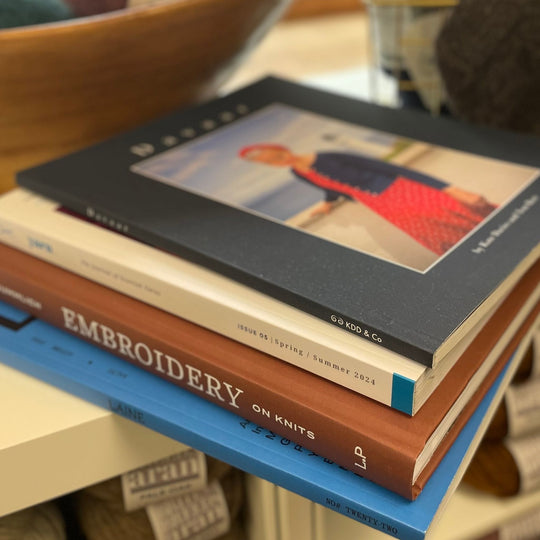Sock Yarns: Superwash & Nylon
In my previous blog post, I talked about some of the pros and cons of a non-superwash, no-nylon sock yarn. This time, I’ll be talking through some of the pros and cons of superwash and yarns with nylon! Naturally, this blog post is a counterpoint to the other post, as some of the pros of one are cons of the other, but it’s nice to be complete.
Superwash
So many yarns available today are superwash that sometimes it's easy to assume that it is the natural state of wool yarns. This is not the case! Wool is naturally not machine washable, due to its ability and tendency to felt and shrink when exposed to heat, water, and/or soap. Superwash processes remove the scales on the wool that felt together under those conditions and often also coat the yarn in a machine-washable coating.
Protection from felting and shrinking can be beneficial for both machine and hand-washing your knits. While machine-washability was not required for most of human history, most people now launder their clothes in washing machines and superwash allows us to wash our handknits in the same way. This can be crucial for items knit for children, pets, or anyone else who needs frequent washing!
Even if you don’t machine-wash your knits, superwash can take the fear out of hand-washing. Handknits will always last longer when hand-washed and with superwash you can’t accidentally felt your knits in too hot water or with too much agitation.
The superwash process also can make dyes more vibrant and crisper in their application. Superwash yarns can also have higher stitch definition, as the fuzzy scales have been removed. Some people who are sensitive to wool are less sensitive to superwash yarns, again because the yarns are not as fuzzy as many non-superwash yarns. Finally, even superwash yarns without nylon often have a plastic-like coating on the yarn which can add some durability.
The major con of superwash is that it is a chemical process applied to a natural fiber. Inevitably, this detracts from some of the natural qualities of the wool, like how it sticks together, its anti-microbial properties, and its breathability. Some knitters find some superwash yarns to feel unnatural, ropey, or plasticky.
Nylon
The primary benefit to including nylon in a sock yarn is durability. Effectively, adding nylon adds a plastic filament to the yarn that will remain even if the wool wears out. If you’ve worn out a commercial sock and saw a netting left behind after the wool or cotton wore away, that was likely a nylon filament knitted into a fabric. This remaining nylon net can make darning easier because the hole hasn’t stretched out. No natural fibers can add the durability that a nylon does.

Happy Medium?
With all this talk of the pros and cons of superwash, non-superwash, nylon, and no-nylon yarns, is there any middle ground? Absolutely! Some sheep breeds yield fibers that are more durable than others, lessening the need for reinforcing nylon. Some superwash yarns are more natural-feeling than others and retain more natural qualities.
With The Woolly Thistle’s focus on wooly wools and yarns with a story, we stock several yarns that walk between the extremes. First, John Arbon Exmoor Sock is a great option for a sock yarn that does have superwash treatment, but the selection of sheep breeds means it still feels wooly and the addition of longwool breeds add durability over a merino. Exmoor sock is also relatively low-nylon at only 10%. This adds durability, but not an excessive amount of plastic. Second, Regia Merino Yak does include superwash merino wool, but also includes some yak fiber, which is also woolier, durable, and adds a nice brown heathering to the base. Finally, our collections of West Yorkshire Spinners Signature 4ply have a higher amount of nylon at 25%, but the yarn is not merino and contains 35% Bluefaced Leicester wool, which makes the feel very wooly still.

Overall, it’s worth experimenting with all the different options for socks: superwash, non-superwash, nylon, low-nylon, and no-nylon. All have pros and cons and are perfect for different applications. In the end, it depends what qualities you like to work with and how you want to treat your socks.
Kelsey Peterson is a knitter, eager student of yarn construction and sheep breeds, and employee of TWT. She is on Instagram as @kcrp.making and on Ravelry as yellowpaperfish.






























2 Comments -
Bunny • -
Janet Wehlitz •
Thanks for the above information. I do use Superwash/Nylon for my socks. But to take it a bit further, I want to make a sweater using wool. I found mostly Superwash/Nylon yarn available to me locally. I’ve watch several podcasts where it was stated that their sweater made with Superwash wool grew. But they don’t say if it had nylon with the wool.
So, my question will Superwash/Nylon yarn have the same stretchiness and the Superwash?
Thanks for any further insight,
Bunny
Greetings,
I am looking for non-superwash no-nylon fingering weight with a tight twist yarn. Do you have any?
Yes, I know what I am getting into with a probably felting wool and no nylon. My body does not get along with man made fibers, and I knit socks on US #000/00 / 1.5/1.75mm needles and twist the stitches on the toe and the heel.
Best regards,
Janet